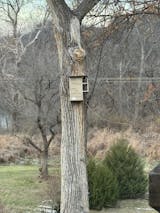Introduction
Welcome to our Learning Center!
Today, we’re diving into the fascinating world of the Carolina Wren, a beloved bird that brings joy to many backyard enthusiasts. Known for its energetic personality and melodious songs, the Carolina Wren is a delightful addition to any garden. Let's explore its characteristics, behaviors, and how you can attract these charming birds to your backyard.
Identification and Characteristics
The Carolina Wren (Thryothorus ludovicianus) is a small, chunky bird with a distinctive appearance. It boasts a reddish-brown upper body, buffy underparts, and a prominent white eyebrow stripe. Both males and females share similar plumage, making them visually indistinguishable. The long, slender bill and cocked tail are key identifiers of this species.
Carolina Wrens are known for their curious and active nature. They often flit around gardens and wooded areas, exploring every nook and cranny. Their loud and varied vocalizations are a hallmark of their presence, with males singing to establish territory and attract mates. The Carolina Wren's song is a cheerful and repetitive series of notes, often described as "tea-kettle-tea-kettle," which can be heard throughout the year.
In addition to their distinctive song, Carolina Wrens have a variety of calls used for communication. These calls include harsh scolding notes when they feel threatened and softer chirps when interacting with their mates. Their vocal repertoire is quite extensive, making them one of the more vocal bird species in North America.
Habitat and Range
Carolina Wrens are non-migratory birds, preferring to stay in their habitats year-round. They are commonly found in brushy thickets, wooded residential areas, and gardens across the eastern United States, from Texas to Connecticut. Their adaptability to various environments makes them a frequent visitor to backyard feeders and nesting sites.
These birds thrive in areas with dense vegetation, which provides ample cover and nesting opportunities. They are particularly fond of habitats that offer a mix of shrubs, trees, and open spaces. Carolina Wrens are also known to inhabit urban areas, making them a familiar sight in many neighborhoods.
The range of the Carolina Wren extends from the southeastern United States up to the Great Lakes region. They are most abundant in the southeastern states, where the climate is milder and vegetation is dense. However, their range has been expanding northward, likely due to milder winters and increased availability of suitable habitats.
Behavior and Diet
One of the most endearing traits of the Carolina Wren is its song. Only the males sing, producing a loud, cheerful series of notes often described as "tea-kettle-tea-kettle". These birds are also known for their creative nesting choices, often building nests in coat pockets, boots, and even mailboxes.
Carolina Wrens primarily feed on insects, spiders, and occasionally small fruits. Their diet includes beetles, caterpillars, ants, and other small invertebrates. They forage actively, hopping along the ground and probing into crevices with their slender bills. Providing a variety of food sources, such as suet and mealworms, can attract them to your backyard.
In addition to their insectivorous diet, Carolina Wrens will occasionally consume small fruits and berries. This dietary flexibility allows them to thrive in various environments, from dense forests to suburban gardens. During the winter months, when insects are less abundant, they rely more heavily on fruits and seeds.
Carolina Wrens are also known for their territorial behavior. Males will vigorously defend their territory from intruders, often engaging in vocal duels with neighboring wrens. This territoriality ensures that they have access to sufficient food and nesting sites, which is crucial for their survival and reproductive success.
Breeding Habits
Carolina Wrens have fascinating breeding habits that contribute to their success as a species. These birds typically begin their breeding season in early spring, with egg-laying starting as early as March in southern states and April in northern regions. The breeding season can extend through late September, allowing for multiple broods.
Carolina Wrens build their nests in a variety of locations, often choosing unconventional sites. Nests can be found in low-lying shrubs, hedges, bushes, and even on the ground or in the lower levels of trees. They are known for their flexibility in nesting sites, utilizing artificial objects such as old buckets, mailboxes, tin cans, coat pockets, and even old shoes.
The nests are typically domed or cupped with a side entrance and are constructed using twigs, grass, bark, and other fine materials. Both males and females participate in nest building, creating a well-packed structure that provides protection for the eggs and chicks.
Carolina Wrens lay between 4 to 8 eggs per clutch, which are creamy or pink-white with brown marks. The female incubates the eggs for about 12 to 14 days, during which the male feeds her. After hatching, the chicks remain in the nest for another 12 to 14 days before fledging. Carolina Wrens can raise two to three broods per breeding season, ensuring a high reproductive output.
Social and Quirky Characteristics
Carolina Wrens are not just known for their songs and nesting habits; they also exhibit a range of social and quirky behaviors that make them fascinating to observe. These birds are highly social and often seen in pairs, engaging in cooperative behaviors that strengthen their bond. They mate for life, forming strong pair bonds that are reinforced through cooperative roosting and feeding.
One of the most charming aspects of Carolina Wren behavior is their willingness to nest in all sorts of creative locations. While they aren’t cavity nesters strictly speaking, they do tend to like at least partially enclosed spaces where they can build themselves a little cave or dome. This adaptability in nesting sites is a testament to their resourcefulness and ability to thrive in various environments.
Carolina Wrens are also known for their vigilant territory defense. Both sexes engage in defending their territory, using songs to communicate their presence and assess threats. They can evaluate the proximity of potential intruders based on the volume of the song or call. Alarm calls serve as immediate responses to predators, with wrens evaluating the threat’s size before reacting.
Another quirky behavior is their tendency to duet. The adults live in pairs all year, and they may 'duet' at any season, with the female giving a chattering note while the male sings. This duet behavior is not only a way to strengthen their bond but also a method of coordinating their activities and maintaining their territory.
Attracting Carolina Wrens to Your Backyard
To invite Carolina Wrens to your garden, consider the following tips:
-
Provide Shelter: Plant dense shrubs and thickets to offer protection and nesting sites. Carolina Wrens prefer areas with ample cover, so incorporating native plants that provide shelter can make your garden more appealing to them.
-
Offer Food: Set up feeders with suet, mealworms, and small fruits. These birds are attracted to a diverse array of food sources, and providing high-protein options like mealworms can be particularly enticing.
-
Water Sources: Ensure fresh water is available for drinking and bathing. A birdbath or shallow water feature can be a great addition to your garden, offering Carolina Wrens a place to drink and bathe.
-
Nesting Boxes: Install nesting boxes to encourage them to settle in your yard. Carolina Wrens are known for their creative nesting choices, so providing a safe and secure nesting box can help them establish a home in your garden.
Creating a welcoming environment for Carolina Wrens involves more than just providing food and shelter. It's important to maintain a clean and safe habitat. Regularly clean feeders and birdbaths to prevent the spread of diseases. Avoid using pesticides and herbicides, as these can harm the insects that Carolina Wrens rely on for food.
Conservation and Citizen Science
Carolina Wrens are sensitive to cold weather, with populations decreasing after severe winters. Participating in citizen science projects like eBird, managed by the Cornell Lab of Ornithology, can help track their populations and contribute to conservation efforts. Visit eBird to learn more and share your sightings.
Conservation efforts for Carolina Wrens focus on preserving their habitats and ensuring they have access to food and shelter. By participating in citizen science initiatives, you can contribute valuable data that helps researchers understand the challenges these birds face and develop strategies to protect them.
One of the key conservation strategies for Carolina Wrens is habitat preservation. Ensuring that natural areas remain intact and free from development is crucial for their survival. Additionally, planting native vegetation in urban and suburban areas can provide important resources for these birds.
Conclusion
The Carolina Wren is a delightful bird that can bring life and song to your backyard. By understanding their habits and providing the right environment, you can enjoy the presence of these charming birds year-round. Join the community of bird enthusiasts and contribute to conservation efforts through platforms like eBird.
Happy birdwatching!






